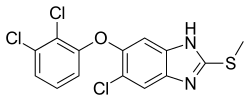Triclabendazole
 | |
| Clinical data | |
|---|---|
| AHFS/Drugs.com | International Drug Names |
| ATC code | P02BX04 (WHO) QP52AC01 (WHO) |
| Pharmacokinetic data | |
| Metabolism | Oxidation to the sulfone and sulfoxide parent compound |
| Biological half-life | 22–24 hs |
| Excretion | Feces (>95%), urine (2%), milk (<1%) |
| Identifiers | |
| |
| CAS Number |
68786-66-3 |
| PubChem (CID) | 50248 |
| ChemSpider |
45565 |
| UNII |
4784C8E03O |
| KEGG |
D07364 |
| ChEMBL |
CHEMBL1086440 |
| ECHA InfoCard | 100.127.414 |
| Chemical and physical data | |
| Formula | C14H9Cl3N2OS |
| Molar mass | 359.658 |
| 3D model (Jmol) | Interactive image |
| |
| |
| | |
Triclabendazole (commercial names: veterinary, liquid: Fasinex; human, tablets: Egaten, both manufactured by Novartis) is a member of the benzimidazole family of anthelmintics. The benzimidazole drugs share a common molecular structure, triclabendazole being the exception in having a chlorinated benzene ring but no carbamate group. Benzimidazoles such as triclabendazole are generally accepted to bind to beta-tubulin and prevent the polymerization of the microtubules of which they are part.
Triclabendazole was initially only developed as an oral route drug, and displays high efficacy against both immature and adult liver flukes.
Since late 1990s, triclabendazole became available as a generic drug, as patents expired in many countries. Many products were developed then. Among them, Trivantel 15, a 15% triclabendazole suspension, was launched by Agrovet Market Animal Health in the early 2000s. In 2009, the first triclabendazole injectable solution (combined with ivermectin) was developed and launched, also by Agrovet Market Animal Health. The product, Fasiject Plus, a triclabendazole 36% and ivermectin 0.6% solution, is designed to treat infections by Fasciola hepatica (both immature and adult liver flukes), roundworms and ectoparasites, as well.
It is on the World Health Organization's List of Essential Medicines, the most important medication needed in a basic health system.[1]
References
- ↑ "WHO Model List of EssentialMedicines" (PDF). World Health Organization. October 2013. Retrieved 22 April 2014.